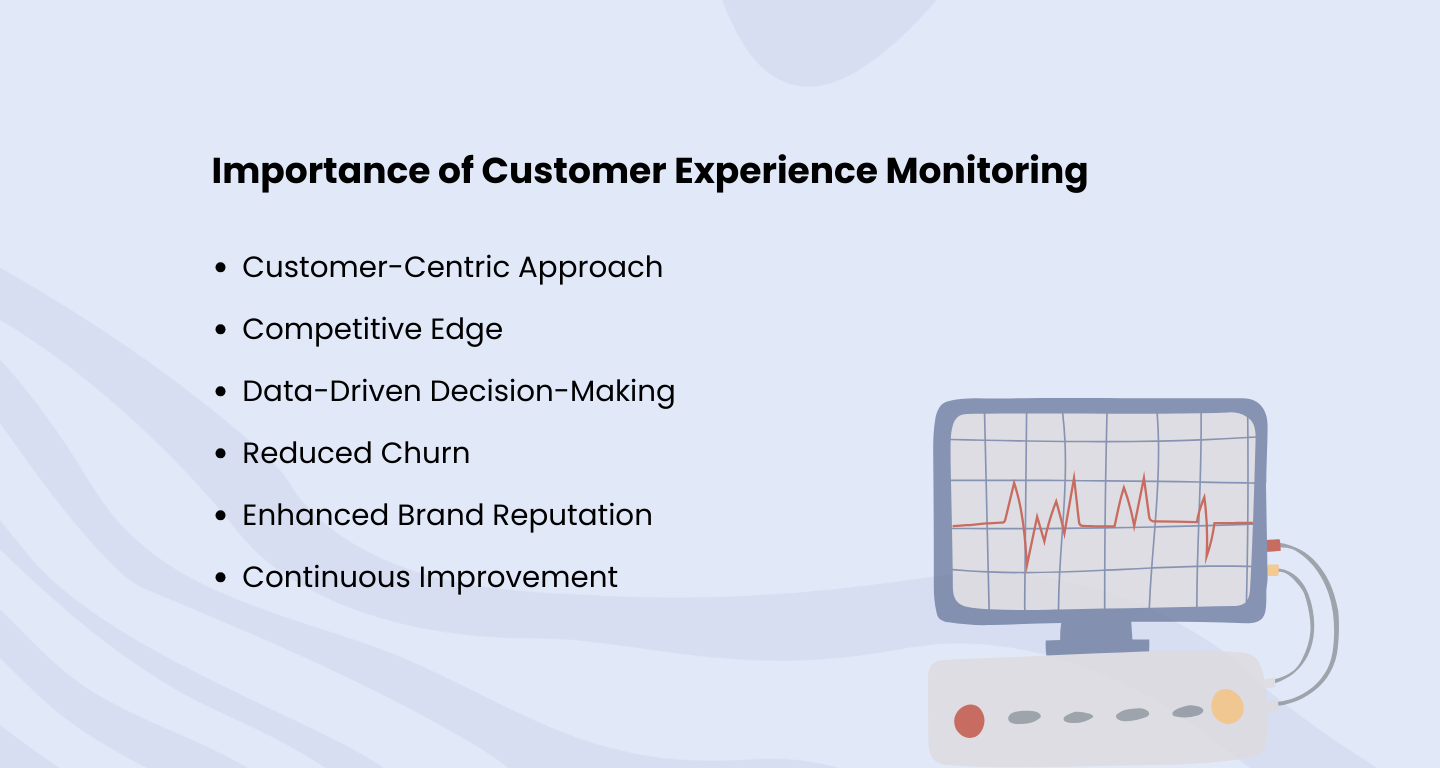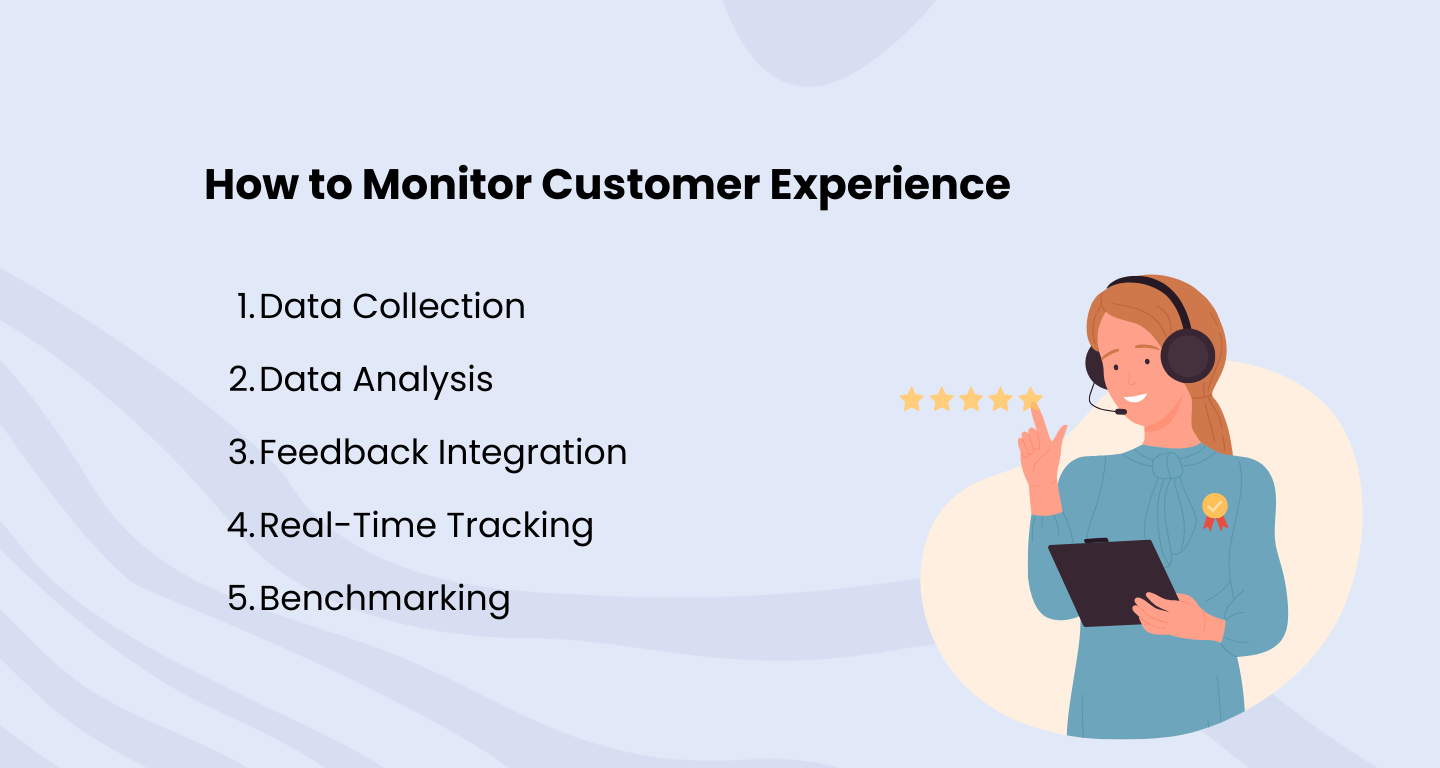Customer Experience
Customer Experience Monitoring: The Path to Customer Delight
Article written by Kate Williams
Content Marketer at SurveySparrow
10 min read
19 September 2025

Do you ever sit back and wonder what your customers think about your brand? If not, it’s time to take a break and ask yourself- “Are we actually listening to their feedback, understanding their journey, and optimizing their experience?” But again, how can you ensure your business is on the right track? That’s where customer experience monitoring comes into play. It provides you with insights that not only gauge customer satisfaction but also equip you with the tools to fine-tune your digital marketing strategies for unparalleled success.
What is Customer Experience Monitoring?
Let’s look at it from the technical side for a bit, shall we? At its core, customer experience monitoring is the systematic process of tracking an evaluating every interaction a customer has with your brand. Oh wait! With “every interaction” we literally mean each and every touchpoint- from the first time they hear about the product to post-purchase support.
Think of it this way: when a customer engages with your business, they embark on a journey filled with various touchpoints. These touchpoints could include browsing your website, reaching out via social media, or even making a purchase. Each of these interactions contributes to their overall perception of your brand.
The best part? Studies show that 86% of consumers are willing to pay more for a better customer experience! This score itself proves how crucial it is to monitor CX, right?
Importance of Customer Experience Monitoring
Now that we know how what’s the deal with CX monitoring, we must take a look at why it is so important for brands and businesses. It is not just a nice-to-have, it’s a must! Here’s why:

1. Customer-Centric Approach
It’s no secret that customers are at the heart of any successful business. It is necessary that we adopt a customer-centric approach by understanding their needs, preferences, and pain points. The invaluable insight enables you to tailor your products, services, and marketing strategies to align with what your customers truly desire.
2. Competitive Edge
With countless options available to consumers, businesses must find ways to differentiate themselves. Delivering exceptional customer experiences sets you apart from the competition. In fact, a study by PWC shows that 73% of consumers point to customer experience as a key factor influencing their purchasing decisions. Monitoring customer experiences helps you consistently exceed their expectations, creating brand loyalty and a competitive edge.
3. Data-Driven Decision-Making
We know one thing for sure- data is king! CX monitoring empowers you with real-time data and insights. You can track customer interactions, analyze their feedback, and identify trends. Armed with this information, you can make informed decisions, fine-tune your marketing strategies, and allocate resources more effectively.
4. Reduced Churn
High customer churn rates can be a significant setback for businesses. By keeping an eye on each interaction, you can identify issues or pain points that may lead to customer attrition. Addressing these concerns promptly can help reduce churn and improve customer retention rates.
5. Enhanced Brand Reputation
A positive customer experience doesn’t just satisfy existing customers; it also attracts new ones. Customers who have had exceptional experiences are more likely to become brand advocates, sharing their happy encounters with friends and family and even on social media. This word-of-mouth marketing can significantly enhance your brand’s reputation.
6. Continuous Improvement
Let’s deal with it. CX monitoring is an ongoing process. It encourages businesses to continuously assess and refine their strategies. By embracing a culture of continuous improvement, you can stay agile and adapt to changing customer expectations.
Now do you understand how customer experience monitoring is just a box to tick?
Before we delve deeper, we need to look into something important.
Importance of CX Monitoring in Digital Marketing
Let’s admit it, digital marketing has become the lifeblood of modern businesses. Why?
- Enhanced Interactions: It optimizes customer interactions by tailoring content and messages to resonate with your audience effectively.
- Personalization: CX monitoring enables personalization at scale, delivering targeted content that boosts engagement and conversions.
- Real-Time Adaptation: It provides real-time insights, allowing swift adjustments to digital strategies based on performance and trends.
- Resource Allocation: Effective resource allocation ensures maximum ROI by identifying high-performing channels and campaigns.
- Customer Retention: Consistent, positive experiences foster loyalty, increasing the lifetime value of customers.
- Competitive Edge: Excelling in digital experiences gives a competitive advantage by staying aligned with evolving customer preferences.
How To Monitor Customer Experience?

1. Data Collection
The foundation of customer experience monitoring lies in collecting data from various sources, including customer surveys, feedback forms, social media interactions, and website analytics. These diverse touchpoints provide a comprehensive view of customer interactions.
2. Data Analysis
Once data is gathered, it’s essential to analyze it thoroughly. Data analysis involves examining the collected information to identify patterns, trends, and areas that require improvement. Tools such as statistical analysis and data visualization aid in extracting meaningful insights.
3. Feedback Integration
Customer feedback is a vital component of the monitoring process. It’s not enough to collect feedback; you must actively integrate it into your decision-making. This includes addressing customer concerns promptly and utilizing their suggestions to enhance their experience.
4. Real-Time Tracking
In the fast-paced digital landscape, real-time tracking is crucial. Implementing tools and technologies that enable real-time monitoring of customer interactions allows you to respond promptly to emerging issues and capitalize on trends as they unfold.
5. Benchmarking
To gauge your performance effectively, benchmark your customer experience metrics against industry standards and competitors. Benchmarking provides a comparative perspective, helping you assess your position in the market and pinpoint areas for improvement.
Read more: How to Measure Customer Experience: A Complete Guide
Key Metrics Used to Monitor Customer Experience
You can’t just rely on intuition when it comes to keeping track of CX. It is a data-driven endeavor that relies on specific metrics to provide insights.
| Metric | Formula |
|---|---|
| Net Promoter Score (NPS) | %Promoters – %Detractors |
| Customer Satisfaction Score (CSAT) | (Number of Satisfied Responses / Total Number of Responses) |
| Customer Effort Score (CES) | (Total Sum of Responses) / (Total Number of Responses) |
| Churn Rate | (Number of Customers at the Start of the Period – Number of Customers at the End of the Period) / Number of Customers at the Start of the Period |
| Customer Retention Rate | ((Number of Customers at the End of the Period – Number of New Customers Acquired During the Period) / Number of Customers at the Start of the Period) |
| Conversion Rate | (Number of Conversions / Total Number of Visitors) x 100 |
1. Net Promoter Score (NPS)
Think of NPS as the ultimate loyalty indicator. It measures how likely your customers are to recommend your brand to others. Scores are divided into Promoters, Passives, and Detractors, offering a clear picture of overall brand advocacy.
2. Customer Satisfaction Score (CSAT)
CSAT provides a snapshot of immediate satisfaction. It asks customers to rate their satisfaction with a recent interaction or experience. High CSAT scores indicate contented customers, while lower scores signal areas for improvement.
3. Customer Effort Score (CES)
CES focuses on the ease with which customers can achieve their goals when interacting with your brand. It measures the level of effort customers must exert to complete tasks. Lower effort scores correlate with higher satisfaction and loyalty.
4. Churn Rate
Churn rate reflects the percentage of customers who discontinue their relationship with your brand within a specified time frame. A rising churn rate is a red flag, indicating the need to address issues in the customer journey.
5. Customer Retention Rate
The retention rate showcases the percentage of customers who continue to do business with your brand over time. High retention rates signify strong customer loyalty and ongoing satisfaction.
6. Conversion Rate
Conversion rate measures the effectiveness of your marketing efforts in turning leads into customers. Tracking this metric helps you evaluate the impact of your marketing strategies on customer acquisition.
When it comes to tracking key metrics for customer experience, having the right tools makes all the difference. SurveySparrow offers a user-friendly platform to create, collect, and analyze customer feedback effectively. With SurveySparrow, you can measure metrics like Net Promoter Score (NPS) and Customer Satisfaction Score (CSAT) effortlessly. It’s a valuable asset for businesses seeking to enhance their customer experiences.
14-day free trial • Cancel Anytime • No Credit Card Required • No Strings Attached
What CX Monitoring Tells About Customer Journeys
Think of CX monitoring as a magnifying glass. It allows brands to zoom right into the intricate details of customers’ journeys and interactions.
- Effective Touchpoints: Identifies which interactions work best and where improvements are needed.
- Customer Sentiments: Reveals customer feelings and emotional reactions during interactions.
- Critical Pain Points: Highlights areas of customer frustration or challenges in the journey.
- Conversion Insights: Pinpoints drop-off points in the conversion process for improvement.
- Customer Preferences: Uncovers preferred communication channels and support options.
- Loyalty Drivers: Identifies factors influencing customer loyalty and retention.
- Trends and Patterns: Reveals evolving trends and patterns in customer behavior.
- Operational Efficiency: Evaluates operational effectiveness, including response times and resource allocation.
Customer Experience Dashboards for Monitoring
Before we wrap up, we need to understand the importance of a dashboard.
Customer experience dashboards are centralized platforms that display real-time data and insights gathered from various customer touchpoints. These dashboards provide a visual representation of customer experiences, making it easier for businesses to make informed decisions.
With the help of customer experience dashboards, you can:
- Monitor customer feedback in real-time.
- Track key performance indicators (KPIs) related to customer satisfaction.
- Identify emerging trends and issues.
- Collaborate with teams to address customer concerns promptly.
Let’s end this with a bang. Here’s a trivia!
The concept of dashboards originated from the world of automobiles. The term “dashboard” was first used to describe the wooden or metal board mounted on the front of a horse-drawn carriage to prevent mud from splattering the driver. When automobiles were invented, this board was repurposed to hold gauges and controls, which inspired the term “dashboard” we use today in the context of data visualization and control panels.
Wrap Up!
So, there you have it! Customer experience monitoring helps you understand what customers love, what they find challenging, and where you can improve. By keeping an eye on key metrics, addressing any issues, and listening to what customers say, you can make their experiences even better. Think of it as creating a masterpiece on your dashboard, with each data point telling a story of happy customers and brand loyalty.
And if you’re looking for a reliable tool to help you gather customer feedback and insights seamlessly, consider exploring what SurveySparrow has to offer. They specialize in simplifying the feedback process, so you can focus on creating exceptional customer experiences.
14-day free trial • Cancel Anytime • No Credit Card Required • No Strings Attached

Make your customers feel heard. Turn feedback into loyalty with SurveySparrow's CX platform.
Kate Williams
Related Articles

Customer Experience
What is Customer Advocacy & 10 Reasons Why It Matters
16 MINUTES
27 July 2019

Customer Experience
How to Craft A Personalized Restaurant Customer Experience
9 MINUTES
31 August 2023

Customer Experience
Customer Onboarding: Step By Step Guide, Best Practices & Examples
19 MINUTES
24 February 2020

Customer Experience
What is Customer Lifetime Value & Strategies to Elevate It
16 MINUTES
6 September 2019
